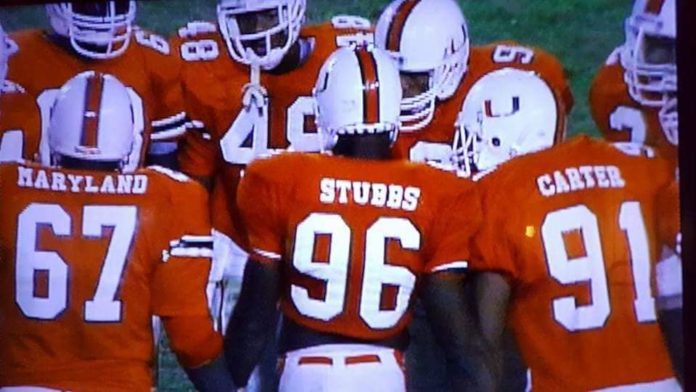|
Getting your Trinity Audio player ready...
|
When Johnson arrived at UM in 1984, he was forced to retain Howard Schnellenberger’s coaching staff. While Johnson embraced the pro-style offense, he did not care for the previous regime’s defensive scheme. The Hurricanes used a 50 Defense implemented by Tom Olivadotti and Bill Trout that was used by most college programs at the time with 5 down linemen and 2 inside linebackers. After consecutive shootout losses to Maryland, Boston College and UCLA to close out the 1984 season, Johnson had enough. He implemented a 4-3 scheme and brought in assistants Butch Davis, Dave Wannstedt and Dave Campo to revamp the defense that would change the game. But Johnson’s master plan was more than just X’s and O’s. It was about Jimmy’s and Joes. His philosophy was to downsize the defense and add speed. He would recruit high school safeties and turn them into linebackers. He recruited high school linebackers and converted them into defensive ends. He would take defensive ends and beef them up into defensive tackles.
There was more method to Johnson’s madness. He had a degree in psychology and knew exactly what he was looking for in a player. He noticed the new breed of athletes coming out of the State of Florida–especially the inner cities of Miami and Fort Lauderdale. These players grew up playing a swaggering style. They celebrated after big plays, danced in the end zone and talked trash. Johnson encouraged his players to express their individuality and the players loved him for it. Intimidation would become a huge component of Miami’s defense.
By 1985, the Hurricane defense became one of the most feared in the country. They particularly feasted on option teams like Oklahoma, Nebraska and Notre Dame. While these teams racked up huge rushing statistics, they could not match up with Miami’s defensive team speed. From 1985 to 1988, the Hurricanes were 44-4. But not everybody was a fan of Miami’s swaggering style, Commentators like Brent Musburger, Beano Cook and Sports Illustrated’s Rick Reilly were huge critics. Many others in the media described Miami’s players as “thugs” and “outlaws”. The Hurricanes became the villains of college football and were particularly unpopular with older white fans who preferred the more traditional programs like Penn State and Notre Dame.
But Miami’s swagger wasn’t without its faults. At times, the program seemed out of control and even too cocky. Miami lost bowl games to Tennessee and Penn State in 1985 and 1986 despite being heavy favorites. The Hurricanes showed up to the 1987 Fiesta Bowl dressed in combat fatigues. They walked out of a steak fry dinner hosted by the Fiesta Bowl. Their players declared they were on a mission and then lost. In the 1991 Cotton Bowl, the Canes displayed swagger at its very best and worst. They demolished the Texas Longhorns 46-3 , but racked up over 200 yards of penalties–most from personal fouls.
The NCAA started to crack down by introducing new rules and penalties designed to discourage and eliminate taunting and celebrating. It was clear the governing body of college sports was specifically targeting the Hurricanes. When the NCAA introduced the new rules, they used highlights from Miami games to illustrate what were violations. Players can no longer take off their helmets or do choreographed dances like the Canes teams of the 1980s. Miami’s influence is still felt. Just about every team today uses the 4 finger salute before the 4th quarter. Many teams run through a cloud of smoke when entering the field–even Notre Dame. Gone are the wishbone and the I-formation option offenses of Oklahoma and Nebraska. All of these changes are because of the 1980s Miami Hurricanes.






